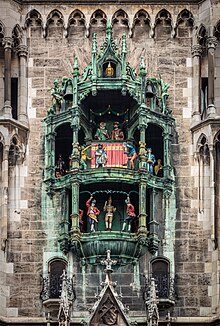Rathaus-Glockenspiel

The Rathaus-Glockenspiel is a large clock. It is in the Marienplatz Square in Munich.[1] It is famous for its large characters. Twice a day, the clock recreates scenes from Munich's history. The first story that it shows is the marriage of Duke Wilhelm V to Renata of Lorraine in 1568. After that, it shows the story of the Schäfflerstanz. This is also called the coopers' dance.
History
[change | change source]The clock has 43 bells and 32 figures. These were added to the Neues Rathaus (New Town Hall) in 1908.[2] Every day at 11 a.m. and 12 p.m. (as well as 5 p.m. from March to October),[3] the clock recreates two stories from Munich’s history from the 16th century. These stories take about 15 minutes.
The top half of the Glockenspiel tells the story of the marriage of the local Duke Wilhelm V (who also founded the Hofbräuhaus) to Renata of Lorraine (Renate von Lothringen). There is also a joust with knights of horses. These horses represent Bavaria (in white and blue) and Lothringen (in red and white). The Bavarian knight (Bayerische Ritter) wins.[4]
After the first story, the second story happens. The Schäfflertanz(otherwise called the coopers' dance) plays out on the bottom half of the clock. This story shows the end of a plague that happened in 1517. [5] The coopers were said to have danced in the streets. These coopers supported residents to leave their homes again after being scared by the plague.[5][6] The coopers were loyal to the duke. Their dance symbolized perseverance and loyalty to authority. The dance is done in Munich every seven years. In 1700, the dance was said to be a tradition. However, the dance was only written down in 1871.[4]
At the end of the show, a very small gold rooster at the top of the Glockenspiel chirps three times. It shows that it is the end of the stories.[4]
Restoration
[change | change source]In 2007, the glockenspiel had a restoration. It was supported by the German Foundation for Monument Protection. [7]
References
[change | change source]- ↑ "Munich" (web). EASY DESTINATION. Retrieved 2008-05-15.
- ↑ "Rathaus-Glockenspiel". Atlas Obscura. Retrieved 2023-08-25.
- ↑ "Glockenspiel im Neuen Rathaus". Retrieved 22 November 2018.
- ↑ 4.0 4.1 4.2 Anderson, Stuart. "Munich Glockenspiel". Destination Munich. Retrieved 29 April 2016.
- ↑ 5.0 5.1 "Rathaus-Glockenspiel". Atlas Obscura. Retrieved 2023-10-26.
- ↑ muenchen.de. "Das Neue Rathaus in München: Von Geschichte bis Architektur - muenchen.de". www.muenchen.de (in German). Retrieved 2023-10-26.
- ↑ "Deutsche Stiftung Denkmalschutz - Rathaus-Glockenspiel - München". Deutsche Stiftung Denkmalschutz (in German). Retrieved 2023-10-26.
48°08′15″N 11°34′32″E / 48.13750°N 11.57544°E
